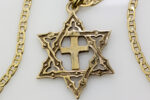“I grew up going to a ‘temple.’ What’s the difference between a temple, synagogue and a shul?”
Essentially, these names are almost synonyms today. However, it is useful to take a look at their historical evolution.
Traditionally, Jewish congregations were known as kehillot kodesh, or Holy Assemblies (in single form, a kahal kodesh). They were also referred to as batei knesset, or Houses of Assembly. The Greek translation συναγωγή (synagoguē) means “assembly.” Today, the Knesset (Parliament) is the Israeli legislative assembly.
While the beth hamikdash (the ancient Jerusalem Temple) existed, the role of synagogues may have been quite different from today. We do know that they existed in Palestine, Babylonia, and elsewhere; we know that the Torah was read in them on a regular basis and tefilot, prayers or psalms, were recited as part of the service.
When the Temple was destroyed by the Romans in 70 CE, the synagogue became more vitally central to the establishment of Jewish communities all over the world.
Synagogues were also called batei tefila, or Houses of Prayer, and batei midrash, or Houses of Study. In Eastern and Central Europe, this led to the synagogue being called a shul, the Yiddish word for school.
When the Reform movement emerged as a lay movement in the first decade of the 19th century, the first “temple” was established in Hamburg, Germany. The use of the name “temple” was intentional. It was a statement about the traditional belief in the restoration of the ancient Temple in messianic times.
These Jewish reformers believed that Jewish continuity in the modern civil state was to be maintained by avoiding any whiff of “dual loyalty.” Could Jews be good German citizens and still hope and pray for the restoration of Jerusalem and the Holy Temple? Would it be a contradiction to the essence of their newly acquired status as emancipated Jews with rights of citizenship?
The establishment of the Hamburg Temple was thus a statement that Hamburg was their Jerusalem, and that their temple was a replacement for the ancient Temple that had stood there before.
This trend continued for well over a hundred years. Since the late 1920s, Reform ideology has moved a long way from those days in Hamburg. The name “temple,” however, remained, and in the 1950s and ’60s spread to the Conservative movement as well.
For the Conservatives, the appellation “temple” referred to the concept of the synagogue being a mikdash me’at, a “diminutive temple,” fulfilling the rabbinic prescription of replacing the ancient temple rites with tefilot and Torah readings and teachings. Conservative Judaism also revised its allegiance to the traditional prayers for the restoration of the ancient Temple and its offerings. They saw these as phenomena to remember but not to be revived in the messianic age.
So today there is really no substantive difference between calling a Jewish congregation a temple, a kehilla or a shul. Whatever one calls our congregations, all of them are striving to transform themselves into centers of Jewish identity, Jewish solidarity and Jewish learning; all of them are committed to the creation and maintenance of caring and compassionate communities.












